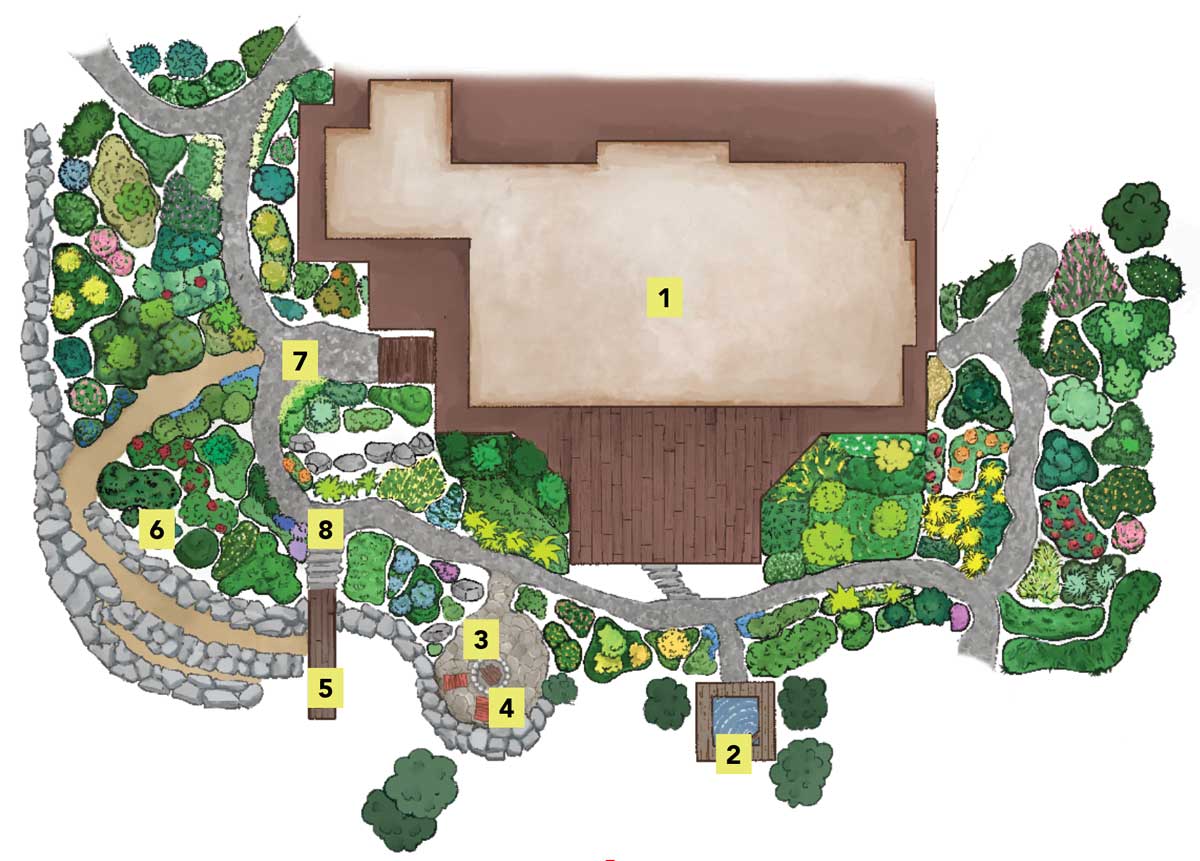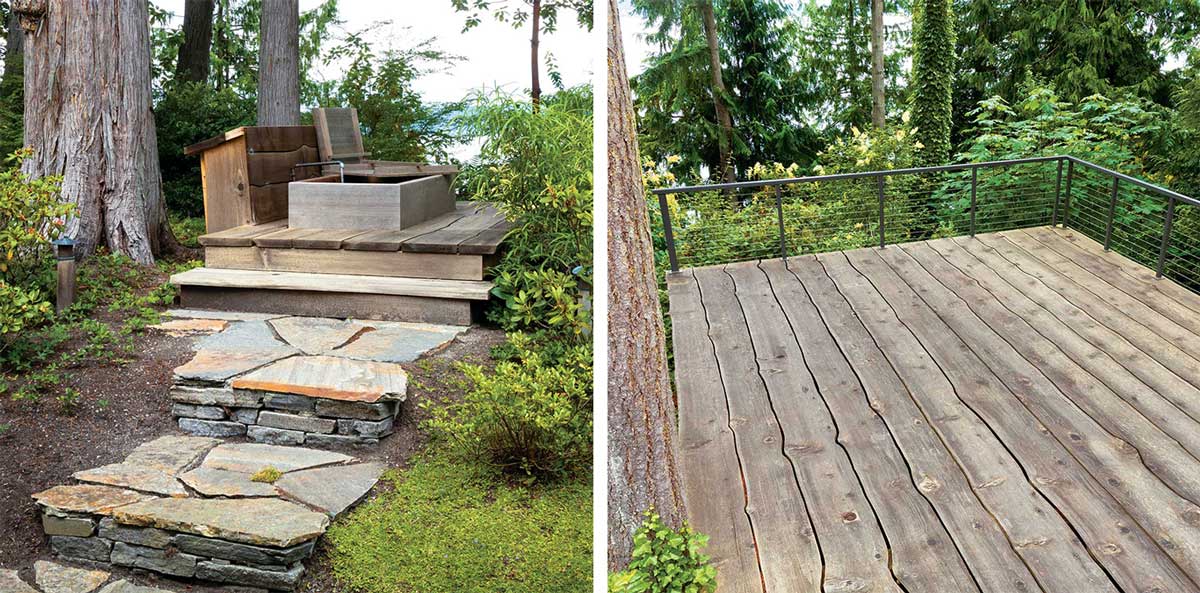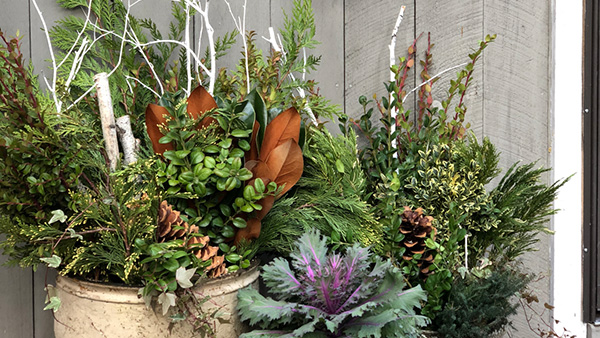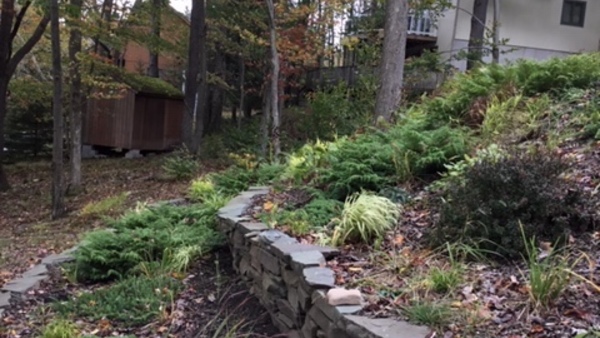
Creating a garden in shade can be tough enough, but when you’re attempting to carve a garden out of a densely wooded lot, the challenges are multiplied. Most gardeners want a landscape that stands out beautifully but doesn’t look out of place or at complete odds with the surroundings. That was exactly the balance the owner of a majestic log cabin at the north end of Bainbridge Island, Washington, was looking to strike for their garden in the woods. The home, nestled in a clearing of Western red cedar (Thuja plicata, Zones 5–8), seems like it grew up with the rest of the forest.
This serene, private spot had a fantastic circle of native trees and shrubs surrounding it, but the existing garden was mundane and tired, with a mossy lawn, boring boxwoods (Buxus spp. and cvs., Zones 5–9), and a series of broken retaining walls. As a board member for the Bloedel Reserve, the homeowner wanted a garden filled with different and unusual plants, but one that also blended into the surrounding forest and honored the native environment. By implementing an organic layout, using natural hardscape materials, and embracing native plant partnerships, that is exactly what he got. See key concepts and plants for designing a garden in the woods.
|The plan|
Blurring the lines between natural and curated
With an eagle’s perspective, it’s easier to see how the various seating areas and planting beds were carved out naturally from the surrounding woodland. The result was a landscape that feels both unique and inclusive of the native environment.

1. Main house
2. Japanese soaking tub
3. Firepit
4. Flagstone patio
5. Live-edge deck
6. Basalt retaining walls
7. Gravel paths
8. Stone access steps
Tips for Creating a Garden in the Woods
Carve out an organic layout while addressing the site issues
First on the list was pushing the natural forest back in a nuanced way to create pockets for planned seating areas, entertaining spots, and garden beds. Although it was a challenge, we worked around the existing large trees—in many cases incorporating them into the garden area—allowing the organic, natural feeling of the site to remain. The background of the entire landscape is filled with trees and other native plants. We kept those in place for several reasons, not the least of which was the privacy from neighbors they created—something many of us can only dream about.

The technical side of this garden, the part that you don’t readily see, is somewhat common to other shady, wooded locations. Forest floors can be damp and a bit muddy, so we took stock: What plants could be removed to improve air circulation and to let in a bit more light, but without drastically altering the natural setting? In this landscape, it was 20 nonnative, ornamental plum trees (Prunus cv., Zones 4–9) planted by the previous owner. Culling these plants enabled future garden beds to have better overall conditions (photo above).
Underground drainage in planting beds (curtain drains) moves much of the excess water into the forest, where the big trees greedily use it up. We installed permeable stone and gravel walkways that created a space for water to sit while it soaks into the ground. Limbing up some of the surrounding large trees also let in more light and allowed their gorgeous, massive trunks to be seen more easily. As a bonus, this created views from the upper deck of the house to the water in Agate Pass below.
Keep the hardscaping natural to blend better with the environs
One of the next things to do was to create access around the house with serviceable and beautiful pathways that kept the spirit of the surroundings in mind. A connection between all the planned elements of the garden was important; after all, what good is a garden if you just sit and look at it instead of get down and interact with it? Using quarried flagstone, we created pathways on the main garden level. Stone steps were installed to lead visitors up to the second level, where there are pathways of decomposed granite. The use of natural stone instead of man-made blocks or inorganic materials was intentional to keep the overall feel in line with the rustic setting. Retaining walls are a necessary evil in this garden due to the sloped site. Basalt, a native rock, was used throughout the space for the walls. We tried to soften the walls as best we could by interplanting with ferns and ground covers and by encouraging moss to grow on them.

This landscape was supposed to be lived in and enjoyed, so that meant seating areas were a must. But the trick was nestling them into the various pockets we had carved out from the woodland to make them seem organic. The property also sits atop a steep embankment that plummets to a beach below, which presented site challenges as well. In keeping with the natural surroundings, a Japanese soaking tub (no jets or lights needed for this serene spot) was installed overlooking Puget Sound at the top of the bank (photo above, left). Three steps lead up to a small cedar deck that we created around the tub and that pays homage to the natural elements all around. A firepit for the cool summer nights we experience in the Northwest was next on the list. We dug out a central area and paved it with rustic flagstone. In the middle is a propane firepit built out of the same neutral-colored stone. Easy to start, smokeless, and easy to extinguish, this firepit makes sure the forest is protected from fire. Native plants surround the patio, augmented with some ornamental cultivars.

An open space between several large trees was just the right spot for another, larger deck in the midst of the woods. Inspired by a tree house, this low-profile seating area embraces the forest instead of rising above it. The deck itself is just as native as the trees surrounding it. Made of large cedar logs cut into slabs, it completely blends in. One edge of each slab was left uncut; called “live edge wood,” these slabs also retained the bark and cambium layer on that edge. The sawn edge was cut to match the pattern of the live edge, creating a soft, sinuous space for rain to fall through to the forest floor below (photo above, right). Natives such as salmonberry (Rubus spectabilis, Zones 4–8), salal (Gaultheria shallon, Zones 6–8), and evergreen huckleberry (Vaccinium ovatum, Zones 7–9) grow up around the deck to complete the forest feel. Every outdoor living element within the garden feels organic, natural, and wholly serene.
Use native-plant partnerships to blur the lines

One of my favorite parts of this garden is the relationship between the native plants and the new specimen plants. In many cases, new plants were chosen specifically to complement the surrounding native plants. For instance, a plethora of native ferns dot the property edges, so when it came time to plant an area in the shadow of the house, we chose evergreen tassel fern (Polystichum polyblepharum, Zones 6–8). Its lush, shiny, medium green fronds stand out a bit more brilliantly than the native ferns, but similar habits and textures connect the two species. From the top deck, the fabulous patterns created by the ferns look like a repeating green mosaic (photo above). The area needed some color, so we chose ground orchid (Bletilla striata cv., Zones 5–9) and rodgersia (Rodgersia podophylla cv., Zones 5–9) and. Although not native, these perennials occur naturally in woodland areas in their places of origin, so they blended seamlessly into this forest garden.

We used a similar approach when selecting choice plants for the other garden areas—looking to showy woodland plants from other regions to enhance this Pacific Northwest land scape. Sasanqua camellia (Camellia sasanqua, Zones 7–9) and Fullmoon® polyspora (Polyspora longicarpa ‘MonSaPaRby’, Zones 8–10) made eye-catching companions for the native rhododendrons (Rhododendron spp. and cvs., Zones 5–9) and mahonia (Mahonia spp. and cvs., Zones 5–9). The leaf shapes and habits of the nonnatives are similar to those of the natives, but the bloom times and foliage appearance differ quite a bit. The outer layer of the garden, where many of the large trees lie, is augmented with various larger, flowering shrubs. This covers up the open space under the canopy and adds color as well. Deer can sometimes wander through the garden, so ‘Plum Passion’ rough-leaved hydrangea (Hydrangea aspera ‘Plum Passion’, Zones 7–9), with its stature and fuzzy leaves, is a perfect resistant variety for this area. And it’s a woodland plant in its native Asia, so it seems to fit naturally into the surroundings (photo above).

The lowest level of the garden consists of ground-hugging plants that mimic the look of the forest floor. Here you’ll find Sutherland begonia (Begonia sutherlandii, Zones 6–9), with its serrated leaves and small orange flowers (photo above). It grows around the large trees, tolerating the shade quite well. We also circled back to ferns in the ground layer to provide continuity with the native edges and the ferns (native and nonnative) scattered throughout the planted areas. The low-growing alpine water fern (Austroblechnum penna–marina, Zones 6–8) skims along the path edges in various spots, not minding the shady conditions. Throughout all of the newly planted areas are numerous examples of thoughtful plant partnerships between the newcomers and native flora. The result is a woodland garden that blurs the line between wild and cultivated.
Embracing the forest enables all types of wildlife to co-exist here. Young eagles land on overhanging branches close to the house. Birds, squirrels, and bees live in the lower layers, with the understory providing shelter and habitat. Anna’s hummingbirds feast on the array of plants, both native and not. And the once-imposing trees now share their space, bringing the sounds of wind and the scent of moss to a more cultivated garden—making this truly a magical garden in the woods.
Susan Calhoun is the owner of Plantswoman Design in Bainbridge Island, Washington.
Photos: doreenwynja.com


















Comments
Log in or create an account to post a comment.
Sign up Log in